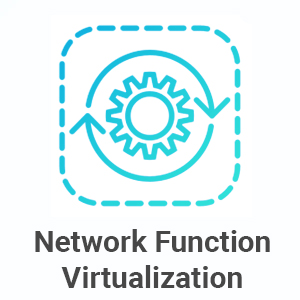


Many service providers simply providing network connectivity for their enterprise customers. They also offer additional services & network functions like network address translation (NAT), firewalls, encryption, domain name service (DNS), caching and others. Traditionally, these network functions will deploy using proprietary hardware at the customer premises. This approach provides additional revenue. But deploying multiple proprietary devices is costly and makes upgrades difficult.
Service providers began exploring ways to reduce cost and accelerate deployment through network functions virtualization (NFV). NFV de-couples’ function like firewalls, encryption from dedicated hardware and moves the functions to virtual servers.
Instead of installing expensive proprietary hardware, service providers can purchase an inexpensive switches, storage and servers to run virtual machines that perform network functions. If a customer wants to add a new network function, the service providers can spin-up a new virtual machine to perform out function.
Fig: High Level NFV Framework
The high level NFV architecture allows service providers to automate at every single level. The major components of this framework include:
It is a kind of cloud data center containing hardware and virtual resources that build-up the NFV environment. These includes servers, switches, virtual machines and virtual switches.
These includes computing resources such as servers, RAM. Storage resources such as disk storage and network resources such as switches, firewalls and routers.
The virtualization layer abstracts the hardware resources and de-couples’ the software from the hardware. This enables the software to progress independently from the hardware. For the virtualization layer we can use multiple open source and proprietary options such as KVM, QEMU, VMware and OpenStack.
These includes virtual compute, virtual storage and virtual network.
This is the second layer of NFV. The VNFs are the basic building block in the NFV architecture, the software implementation of the network functions. VNFs can be connected together as building blocks to offer a full-scale network service. This is known as service chaining. Examples of VNFs includes vIMS, vFirewalls and vRouters.
This is the third component of NFV architecture. It includes virtualized infrastructure manager, VNF manager and orchestrator.
It controls n managers interaction of VNF and NFVI compute, storage and network resources. It also has necessary deployment and monitoring tools for the virtualization layer.
VNF manager manages the life-cycle of VNF instances. It is responsible to initialize, update, query, scale and terminate VNF instances.
It manages the life-cycle of network services which includes instantiation, policy management, performance management and KPI monitoring.
OSS deals with network management, fault management, configuration management, service management and element management. BSS deals with customer management, operations management, order management, billing and revenue management.
NFV provides the following benefits to network operators:
NFV enable dynamic provisioning of network services that support applications. With NFV the service providers grant the flexibility to move their network functions from a dedicated appliance to generic servers. With its benefits of scalability, security and cost-effectiveness, NFV is helpful to shape the service provider networks.